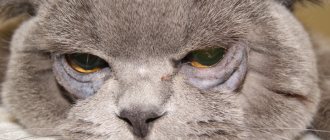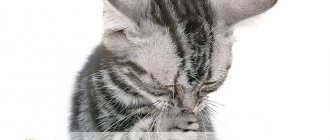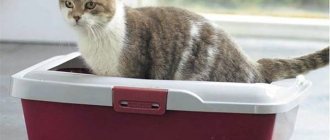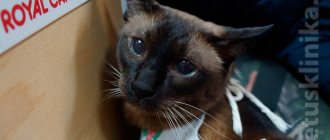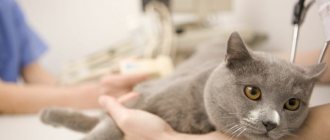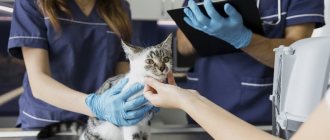The animal's body, like the human body, signals problems and failures. If your cat has water in one eye, squints it, looks sick, and refuses to eat, you should immediately contact a veterinarian. He will tell you what to do at home, what medications and how to give them in order to restore your pet’s health and prevent his blindness.
Symptoms of eye lacrimation
If a cat has watery eyes for a long time in one or both eyes, there is brown discharge or with a whitish tint, this is a manifestation of several serious diseases at once. Along with them, the animal also exhibits other signs of pathology:
- severe itching (the cat constantly rubs its eyes with its paws);
- lethargy and poor appetite;
- redness of the whites;
- increased body temperature;
- photophobia and swelling of the eyelids;
- dried crusts and hair loss in the corners of the eyes.
Pathological discharge may change its character. At first they are liquid and transparent, and after a day they are already thick and with pus, then they pass, then they appear with renewed vigor. If one of your cat's eyes is watery, swollen and squinting, you should not delay your visit to the veterinary clinic. Timely measures will completely relieve your pet from suffering and restore his vision.
Diagnosis of flu and colds
If you suspect a disease, you should seek help from a doctor. For adults - a therapist, for children - a pediatrician. The consultation takes place in several stages.
- Initial examination. The doctor will ask you questions about your health, review your medical history, and refer you for tests and diagnostics. After a private consultation, the therapist prescribes an ultrasound of internal organs and laboratory tests to detect viruses and infections.
- Establishing diagnosis. After collecting anamnesis, the specialist will identify the disease based on the results obtained. He will tell you about the causes of your condition, prescribe treatment with various methods and drugs, or refer you for hospitalization.
- If necessary, the therapist will refer you to a specialist for further examination.
As for the examination of the child by the pediatrician, parents must be present. This helps the doctor quickly find a common language with the patient. Initially, the pediatrician listens to the lungs, measures the child’s body temperature, and examines the throat for inflammation.
The specialist listens to parents' complaints about the child's health. After this, it is necessary to undergo an examination to diagnose the disease. The pediatrician will order a blood/urine test, as well as additional tests if necessary (scraping, x-ray, bronchoscopy). At a follow-up consultation, the specialist will make a diagnosis, prescribe medication, or refer you to a specialized specialist.
Natural causes of tearing
Sometimes a domestic cat's eye becomes swollen for a short time, does not open, and waters. This is quite a normal situation after sleep. It is enough to rinse it with warm brewed black tea or running water. Abundant transparent tears often appear in purebred long-haired pets. Their tear ducts are irritated by their long fur. To prevent the animal from suffering, it must be periodically combed, the hair on its face trimmed, and the eyelids treated with special drops.
A little tearing is considered normal in Scottish, Persian and British cats. These breeds “cry” due to the anatomical features of the skull. They have shortened nasal and tear ducts. Watery eyes usually do not cause discomfort to your pet. All that is required from the owner is hygienic treatment and observation. If the cat’s eye is already swollen and very watery, pus has appeared - these are symptoms of an infectious process.
Measures to prevent eye diseases
It is easier to prevent an ophthalmic disease in an animal than to treat it. Prevention includes:
- regular vaccination;
- preventing pet hypothermia;
- examination of the animal’s visual organs after street walks;
- washing the mucous membrane and eyelids with saline solution if wounds are found on them;
- timely contact a veterinarian.
A cat squinting its eye is not necessarily due to illness. Sometimes this is a variant of the norm, for example, when the animal is sleepy or calm. It is necessary to seek veterinary help if this symptom persists for a long time and is accompanied by lacrimation, pus discharge and deterioration in the pet’s physical condition.
Eye diseases in animals. Treatment of eye diseases at the IVC MBA.
All information posted on the site is provided in accordance with the User Agreement and is not a direct instruction to action. We strongly recommend that before using any product, you must obtain a face-to-face consultation at an accredited veterinary clinic.
Painful tearing
Experienced breeders know that if a cat has one eye watering for a long time, this is a sign of a serious pathology:
- Cold. Animals often have watery eyes if they are hypothermic and have contracted the virus. In addition to eye discharge, body temperature rises. The pet refuses food and constantly sleeps.
- Conjunctivitis is an infectious disease caused by pathogenic microflora, for example, staphylococci or chlamydia. As a rule, with such an ophthalmological pathology, the cat is afraid of bright light, hides under the sofa or bed, and has watery eyes in one or both eyes. The veterinarian will determine what to do.
- Worm infestation. Intestinal parasites very often cause excessive tearing in pets. They affect not only the digestive tract, but also settle in the visual organs, causing severe suppuration and inflammation. The owner immediately notices that the cat’s eye is swollen and watery. After antihelminthic therapy, these symptoms disappear.
- Trichiasis is a rare pathology characterized by abnormal eyelash growth in cats. They appear inside the eyelid, irritate the tear ducts, and cause infection. The animal constantly rubs its eyes and squints. The problem can only be solved surgically. Simple rinsing with medicinal or folk remedies does not help in such a situation.
- Entropion of the eyelids is a problem that often appears in Sphynxes and other hairless breeds. It can only be solved surgically. Antibacterial therapy is carried out after the operation. After a few days, the animal’s vision is completely restored, and all unpleasant symptoms disappear.
- An allergic reaction often causes swollen eyelids in pets and excessive tear production. It is triggered by various allergens: pollen, household chemicals, cosmetics, especially aerosols, new food with additives, tobacco smoke, poplar fluff or household dust. The pet's eyes become red, frequent sneezing and scabies appear. To save him from suffering, they are treated with antihistamines and, if possible, protect the pet from contact with irritants.
- Chemical or thermal burns of the eyelids and cornea. Pets get such injuries if household chemicals, all kinds of solvents, dyes, and varnishes come into contact with their faces. Before sending to the veterinarian, you need to find out what solution the pet was burned with - alkaline or acidic. If alkali gets into a cat's eyes, at home they are washed with an aqueous solution of boric acid, and if the eyelids are burned by acid, a soda solution is suitable. When you don’t have such products at hand, it’s enough to rinse the face with plain tap water.
- Foreign objects. If your cat's eye is red and watery, it could be a piece of hard food, a splinter of wood, a speck of sand, or sand. They rupture the membranes of the eyelid, cause inflammation, swelling, and activate the production of tear fluid. To remove foreign objects, the pet's eyes are washed with running water and then wiped with an antibiotic solution. If the cornea is seriously damaged, independent actions can only cause harm and cause complete blindness.
- Injuries. Very often, if several mature cats live in a house, clashes and fights occur, as a result of which the pets injure each other’s eyelids with their claws. It often happens that a cat's red eye becomes watery after a walk. He could have been injured by a dry branch on a tree or a stem in the grass.
Important! In any case, if pathological symptoms appear in a pet, a veterinarian examination is necessary. He will examine the cornea and determine the extent of damage to the eye. If conjunctivitis is suspected, an analysis of the eye fluid will be required to determine the causative agent - fungi, bacteria or viruses. In special cases, an ultrasound of the eyes, tests for the patency of the lacrimal ducts, and ophthalmoscopy are performed.
Why do cats have lacrimation?
In cats, lacrimation from the eyes can be either natural or pathological. In the first case, nothing threatens the health of the pet and only careful care of the cat is required. Pathological lacrimation is very unsafe for the animal, as it can lead to loss of vision. In this case, veterinarian intervention is required.
With pathological lacrimation, a watery discharge of a coffee-colored, cloudy or transparent color appears on the cat’s eyes. In addition, it should be noted that such lacrimation causes unpleasant feelings in the pet: itching, the cat constantly rubs its eyes with its paws, becomes lethargic, its body temperature may rise, loss of appetite, and the eye itself may close and swell.
With pathologies, a cat may cry due to...
- Mechanical damage and injury . This is also called keratitis, or inflammation of the cornea. Foreign objects can get into the eye area and cause discomfort in the pet and develop an inflammatory process. Keratitis is accompanied by a fear of light in pets, discharge of pus from the eyes, and redness of the eye area. The cat's eye closes and tears may flow from it.
- Burn . In the home, any aggressive household chemical can cause a corneal burn. Cats are often curious, so if a cat becomes interested in cooking, it can get burned and start squinting.
- Allergic reaction . Not only people, but also animals are susceptible to various manifestations of allergies. Pets can be allergic to different things: new food, household chemicals, fluff, tobacco smoke, etc.
- Colds . If a cat has a cold, its reaction is often manifested by constant lacrimation. In this case, you should immediately consult a doctor.
- Conjunctivitis . Chlamydia, various bacteria, viruses, and fungi cause a similar infection. The eye may become red and fester. For conjunctivitis, as for colds, you should consult a veterinarian.
- Incorrect eyelash growth . Eyelashes grow incorrectly, causing discomfort to the animal. In this case, you should also contact your veterinarian.
- Glaucoma . Your pet has increased intracranial pressure due to injury or illness. Glaucoma leads to enlargement of the eye and decreased visual acuity. Also, owners may often notice that with glaucoma, the animal’s eye is swollen. In the later stages of this disease, blindness is possible without any treatment.
- Epiphora, or profuse lacrimation . The owner may notice that the pet is constantly crying. Epiphora can lead to partial or complete blockage of the nasolacrimal duct. An advanced form of this pathology can cause dermatitis.
- Parasites . In pets, not only the intestines can suffer, but also the organs of vision, because worms are also found there. They cause inflammation, severe lacrimation and pus.
Of course, if you find that your cat’s eye is watery and won’t open and there is one of the above signs, you need to contact a veterinarian.
Watery eyes can also occur due to natural causes.
- After sleep . In this case, the cat can remove the tears itself by washing, or you just need to wipe the eye area with boiled water.
- Long wool . It may get into the eye and cause irritation. Owners should regularly trim the fur on their pet's face and brush it regularly.
- Sphynx breed . Lacrimation is a feature of the body. Doctors often diagnose this breed with “entropion,” which means the lower and upper eyelids may roll up. In this case, only surgery will help the pet.
- Age . Excessive tearfulness is characteristic of kittens whose eyes have recently opened. Often, as the cat grows up, such profuse tearing stops. The owner can wipe the pet's eyes several times a day with a cotton swab dipped in warm boiled water to prevent the kitten's eyes from sticking together.
Treatment at home
When infectious eye diseases are detected in cats, they are prescribed instillation and rinsing with aqueous solutions of antibiotics:
- Sofradex;
- Sulfacyl sodium;
- Kanamycin;
- Levomycetin.
In this case, not only the affected eye is treated, but also the second one, even if it looks healthy. Apply an antibiotic ointment (for example, tetracycline) 2-3 times a day and wipe the eyelids with Furacilin solution. In case of severe swelling of the eyelids and severe pain, a solution of hormones (hydrocortisone and novocaine) is injected into the animal’s eyeball. Such procedures are carried out in a hospital.
If a foreign body gets into the pet's eye, the veterinarian removes it with a cotton swab, injection needle or tweezers, and then injects an anesthetic into the eyeball.
Excessive lacrimation caused by an allergen is treated with antihistamines and hormonal ointments.
As additional remedies to basic medications, some cat owners use tinctures and decoctions of beneficial herbs. For example, sage, chamomile, St. John's wort, calendula. They wash your pet's eyes twice a day. The procedures help get rid of pus, stop inflammation, and heal affected mucous membranes. Instead of herbal recipes, it is allowed to use strong brewed black tea or a weak solution of manganese.
How is eye injury treated?
Treatment is selected based on the type and extent of eye damage. In mild cases, we manage with drug therapy, which includes antibacterial drugs, non-steroidal anti-inflammatory drugs, painkillers and hormonal eye drops. For moderate and severe burns, the patient is hospitalized; for serious wounds, surgery is performed. Treatment after an eye injury involves using drops recommended by your doctor.
Consequences of eye injury
The consequences of damage depend on its extent and the quality of assistance provided. Doctors treat wounds and carry out all necessary manipulations, so if you quickly go to the emergency room, there will be fewer complications. Undesirable consequences are associated with infection entering the blood or even greater injury as a result of rash actions.
If a person does not receive timely medical care, scars remain, the soft tissues around the eye are deformed, and visual acuity decreases until it is completely lost.
If the infection enters the blood, sepsis develops - inflammation that is dangerous to the entire body. Accumulating pus affects the internal structures of the eye, sometimes reaching the brain, causing inflammatory processes in the body.
